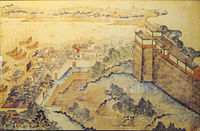
Photo from wikipedia
This study develops an agent-based and spatial genetic algorithm framework called Population-driven Urban Land Development (PDULD) to simulate urban land development and population dynamics. In the model, household-life cycles promote… Click to show full abstract
This study develops an agent-based and spatial genetic algorithm framework called Population-driven Urban Land Development (PDULD) to simulate urban land development and population dynamics. In the model, household-life cycles promote their location and relocation desires and, thus, form local housing market demand. Land developers and local governments make optimal use of current land reserves to meet housing demands. Land development in an area is treated as a multi-goal optimization activity. Community cohesion theory is introduced into the model to illustrate the influence of the population on the spatial structure of urban land use. The study uses the Spatial Genetic Algorithm to help find the best land development choices to achieve social, economic, and environmental goals. The results show that the model simulates population distribution quite well and interprets the real land use at a neighborhood level with a reasonable accuracy. A historic data comparison indicates that government policies and increasing land prices have dominated the process of land development in Shanghai based on a case study of Jiading New City.
Journal Title: Applied Spatial Analysis and Policy
Year Published: 2018
Link to full text (if available)
Share on Social Media: Sign Up to like & get
recommendations!